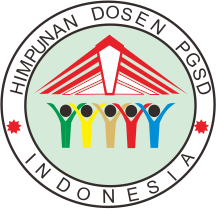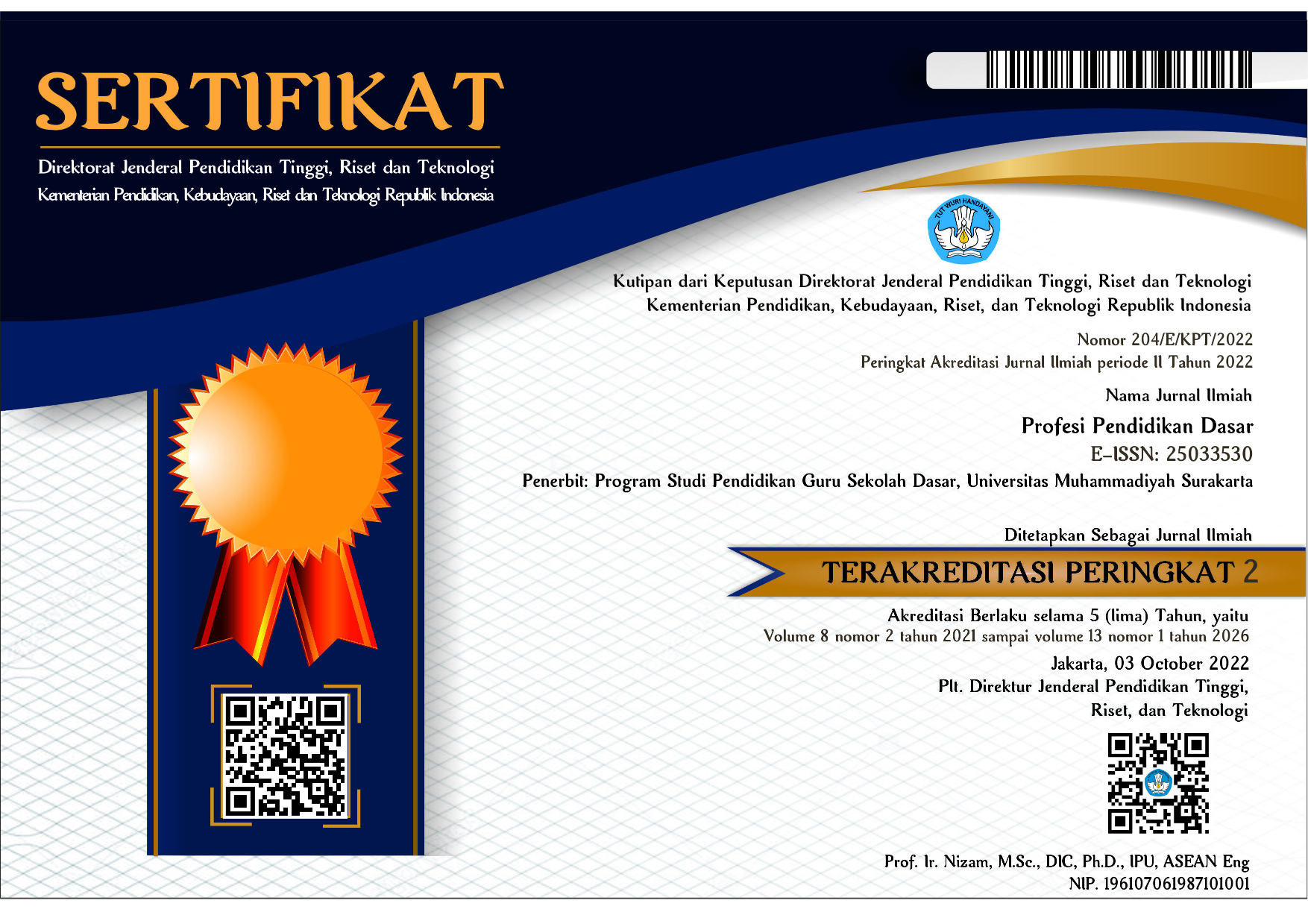E-Money Tab As An Attendance Tracker For Elementary School Students
Minsih Minsih(1*), Fiki Nur Rahmawati(2), Rusnilawati Rusnilawati(3)(1) Universitas Muhammadiyah Surakarta, Surakarta
(2) Universitas Muhammadiyah Surakarta, Surakarta
(3) Universitas Muhammadiyah Surakarta, Surakarta
(*) Corresponding Author
Abstract
Keywords
Full Text:
PDFReferences
Abbas, S., & R. (2018). “Punishments To Strengthen Students’ Discipline for Future Education.” Advances in Socisl Science, Education and Humanities Reserch 125.
Annisa, F. (2018). “Planting Of Discipline Character Education Values In Basic School Students.” International Jurnal of Education Dynamics 1(1): 109.
Asmira. (2016). “Efektivitas Penerapan Absensi (Fingerprint) Dalam Meningkatkan Disiplin Kerja Pegawai Di Kecamatan Anggana Kabupaten Kutai Kartanegara.” Journal Ilmu Pemerintahan 4(3): 1017.
Budiman, H. (2017). “Peran Teknologi Informasi Dan Komunikasi Dalam Pendidikan.” Jurnal Pendidik Islam 8(1).
Creswell, J. W. (2010). Research Design Pendekatan Kualitatif, Kuantitatif, Dan Mixed. Yogyakarta: Pustaka Pelajar.
Diartono, D. A. (2010). “Integrasi Sistem Presensi Finger Print Dan Sistem Sms Gateway Untuk Monitoring Kehadiran Siswa.” Jurnal Teknologi Informasi 15(1).
Fakih, A., Dkk. (2015). “Pemanfaatan Teknologi Fingerprint Authentication Untuk Otomatisasi Presensi Perkuliahan.” Journal of Information System Engineering and Business Intelligence 1(2): 43.
Inayatillah. (2015). “Dampak Penerapan Absen Sidik Jari (Fingerprint) Terhadap PNS Perempuan Di Lingkup UIN Ar-Raniry Banda Aceh.” Internasional Journal of Child and Gender Studies 1(2): 28.
Minsih. (2015). “Pelaksanaan Layanan Dasar Bimbingan Dalam Membentuk Karakter Siswa Di SD Muhammadiyah Program Khusus Kota Surakarta.” Profesi Pendidikan Dasar 2(2): 112.
Mubarok, A., & Santoso W. H. (2017). “Penerapan SMS Gateway Sebagai Alternatif Peningkatan Kedisiplinan Siswa Di SMK Anwarul Maliki Sukorejo Pasuruan.” Jurnal Pendidikan Agama Islam 2(2).
Nani, A. Dkk. (2020). “Efektivitas Penerapan Absensi Fingerprint Terhadap Disiplin Pegawai Di Kantor Kecamatan Sorawolio Kota Baubau.” Jurnal Studi Ilmu Pemerintahan 1(1): 8.
Prasongko, C., & Dewi, S. (2015). “Aplikasi Presensi Siswa Berbasis Web Yang Terintegrasi Dengan SMS Gateway Studi Kasus SMP Muhammadiyah 4 Yogyakarta.” Jurnal Sarjana Teknik Informatika 3(1): 14.
Putra, D. S., & Ami F. (2018). “Perancangan Aplikasi Presensi Dosen Realtime Dengan Metode Rapid Aplication Development (RAD) Menggunakan Fingerprint Berbasis Web.” Jurnal Pengembangan IT 3(2): 168.
Putra, R. A. W., Dkk. (2019). “The Role Of School’s Rules In Forming Student Discipline Behavior At State 2 Elementari School Sendangsari Sub District Batuwarno Wonogiri District Year Lessons 2019/2020.” Civis Education And Social Sciense Jurnal 1(1).
Putri, D. P. (2018). “Pendidikan Karakter Pada Anak Sekolah Dasar Di Era Digital.” Jurnal Pendidikan Dasar 2(1).
Rahayu, M. I., Dkk. (2018). “Pengembangan Sistem Informasi Presensi Perkuliahan Di Fakultas Teknik Mesin Dan Dirgantara Institut Teknologi Bandung.” Jurnal Teknologi Informasi dan Komunikasi 7(1): 9.
Rahmawati, Heni. (2020). “Analasis Penerapan E-Rapor Dalam Penilaian Kurikulum 2013 Di SD Muhammadiyah 1 Ketelan Surakarta Tahun 2019/2020.” Universitas Muhammadiyah 1 Ketelan Surakarta.
Samino. (2015). Filsafat Pendidikan Rujukan Bagi Pendidik Dan Calon Pendidik. Kartasura: Duta Permata Ilmu.
Sujana, D., Dkk. (2019). “Komparasi Analisa Sistem Simulasi Vending Machine Autimatic Cash Money Dan E-Money Di Universitas Islam Syekh Yusuf Tangerang.” JUTIS 7(1): 11.
Sukmadinata, N. S. (2011). Landasan Psikologi Proses Pendidikan. Bandung: PT Remaja Rosdarya.
Wibowo, S., & S. (2018). “Analisis Dan Perancangan Sistem Informasi Presensi Siswa Berbasis Android Pada SD Dan SMP Kanaan Global School Jambi.” Jurnal Manajemen Sistem Informasi 3(2).
Widyahening, E. T., Dkk. (2016). “Literary Works and Character Education.” International Journal of Language and Literature 4(1): 177.
Wulandari, D., Dkk. (2018). “Factors Affecting The Adoption Of Electronic Money.” International Jurnal of Civil Engineering and Technology 9(7): 1928.
Wulandari, D. (2019). “Respon Aparatur Sipil Negara (ASN) Mengenai Kebijakan Absensi Fingerprint Dalam Mendisiplinkan Pegawai.” Institut Agama Islam Negeri Bengkulu.
Wuryandani, W., Dkk. (2014). “Pendidikan Karakter Disiplin Di Sekolah Dasar.” Cakrawala Pendidikan (2).
Article Metrics
Abstract view(s): 1174 time(s)PDF: 785 time(s)
Refbacks
- There are currently no refbacks.


















